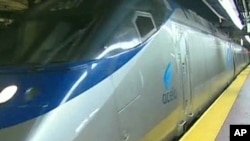Europe and Asia have enjoyed high speed passenger trains for years, but the United States has lagged behind, holding on to older and slower trains, except for one route between Washington, New York and Boston. But things are about to change. President Obama announced plans to develop high-speed rail corridors in the United States, dedicating an initial $8 billion dollars to begin the work. Producer Zulima Palacio looks into one of the largest US transportation projects in years. Debora Tate narrates.
A high-speed French train can reach 574 kilometers per hour, but the record was set a Japanese train with a speed of 581 kilometers per hour. China is also catching up.
Meanwhile in the U.S., the fastest train, known as Acela, reaches less than half those speeds (241 kilometers per hour) and only operates between Washington, New York and Boston.
Only half the trains in the U.S. can travel up to 170 kilometers per hour, but American trains are about to change, according to U.S. Secretary of Transportation Ray LaHood.
"The day will come when you can see travel between Los Angeles to San Francisco in under 3 hours going 220 miles per hour [354 kph]," said LaHood.
Construction of California's high-speed train could start in 2012. Experts say service may begin by 2020.
And conditions might be right for a high-speed American train. President Obama recently announced that $8 billion in stimulus funds would go to developing high-speed rail corridors.
The president presented the project as a vehicle for job creation.
John Risch is with the United Transportation Union, the largest union representing railroad workers in the United States.
"In California alone it is estimated that 160,000 construction jobs could be created just to build those two high speed rail corridors," said Risch.
The project will develop 13 corridors between heavily populated areas, but only the ones in California and Florida will be truly high speed because, says Amtrak's Steve Kulm, those states will be the only ones to build tracks exclusively for high speed trains.
"There is a difference between Europe and Asia and high speed here in America. In Europe and Asia they are dedicated tracks where only high-speed trains operate on. Here in America our passenger trains share tracks with slower freight trains," explained Kulm.
And most of the federal funds will go for improving infrastructure and service on slower trains. Kulm says Amtrak's Acela is already competing with the airlines.
"Before, between Washington and NY the passenger train only had about 20 percent of the market. Today, Amtrak has 61 percent of the market compared to air flights. Same thing happens in the north part of the corridor between NY and Boston," added Kulm
Environmental groups have applauded the project. Howard Learner is executive director of the Environmental Law and Policy Center, which advocates for the development of eco businesses.
"At a per-passenger-mile basis, rail is about three times as efficient as travel by car, in terms of fuel efficiency, and six times as efficient as travel by air, so there are pretty substantial pollution reduction benefits both in terms of greenhouse gases and other pollutants," noted Learner.
John Risch of the United Transportation Union says there are more benefits.
"Passenger trains are the safest form of transportation available with the exception of the elevator. Trains are fuel efficient, they relieve traffic and airport congestion and they also reduce our dependence on foreign oil, making passenger trains the safer, cleaner, greener transportation option," said Risch.
Critics say $8 billion will start many small projects but won't finish them. Supporters of the plan say that, nevertheless, it will lay the foundation for a new kind of mass transportation in the United States.
High Speed Trains in US to be Slower Than Those in Europe, Asia






